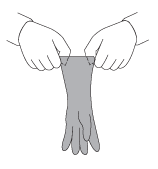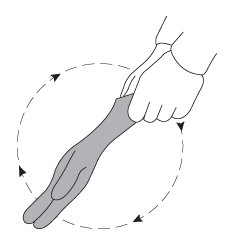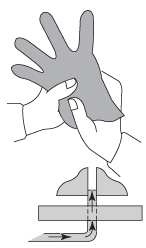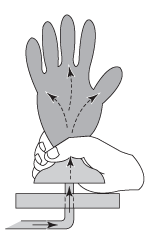Chemical Protective Clothing - Glove Selection
On this page
- What should I know first about chemical protective clothing?
- What is meant by permeation rate, breakthrough time, and degradation?
- How do I choose the right material for the job?
- What are some examples when selecting skin protection?
- What are some other points to remember about skin and hand protection?
- How can gloves be tested for holes or leaks?
- What is meant by a workplace evaluation?
- Does the use of chemical protective clothing require a PPE program?
- What are some sources of information for chemical protective clothing material selection?
What should I know first about chemical protective clothing?
Back to topWorkplaces should follow the hierarchy of controls when addressing hazards.
Personal protective equipment (PPE) is considered the least effective control and refers to anything workers wear to help protect them from workplace hazards. Chemical protective clothing should not be considered as a replacement for engineering control methods. However, there are often few alternatives available, or an emergency (e.g., a spill) requires their use. Since clothing is the last line of defence for protecting the skin, care must be taken to ensure it provides the level of protection expected.
When selecting the appropriate clothing, be aware that the phrase commonly found on safety data sheets (SDSs) "Wear impervious (or impermeable) gloves," has very limited value. It is technically inaccurate. No glove material will remain impervious to a specific chemical forever. No one glove material is resistant to all chemicals. Some chemicals will travel through or permeate the glove in a few seconds, while other chemicals may take days or weeks.
The SDS should specify the appropriate type of chemical protective material needed(e.g., neoprene, butyl rubber). If this information is missing, contact the supplier or manufacturer of the product. Manufacturers of chemical protective gloves and clothing may also assist customers in making the appropriate choices.
What is meant by permeation rate, breakthrough time, and degradation?
Back to topPermeation rate is the rate or speed at which the chemical will move through the material. It is measured in a laboratory and is expressed in units such as milligrams per square meter per second (or some other [weight of chemical] per [unit area of material] per [unit of time]). The higher the permeation rate, the faster the chemical will move through the material.
Permeation is different from penetration. Penetration occurs when the chemical leaks through seams, pinholes and other imperfections in the material: permeation occurs when the chemical diffuses or travels through intact material.
Breakthrough time is the time it takes a chemical to permeate completely through the material. It is determined by applying the chemical on the glove exterior and measuring the time it takes to detect the chemical on the inside surface. The sensitivity of the analytical instruments used in these measurements influences when a chemical is first detected. The breakthrough time gives some indication of how long a glove can be used before the chemical will permeate through the material.
Degradation is a measurement of the physical deterioration of the material due to contact with a chemical. The material may get harder, stiffer, more brittle, softer, weaker, or may swell. The worst example is that the material may actually dissolve in the chemical.
How do I choose the right material for the job?
Back to topThe appropriate material for each job must be chosen with care. Before deciding about which kind of glove or other chemical protective clothing to use, you should gather and analyze information on a number of factors. Be sure to:
- Complete an accurate description of the task.
- Identify all hazards that may require hand protection. This identification should include a list of the chemicals involved as well as physical hazards such as abrasion, tearing, puncture, fire/flames, temperature, and biological hazards. The hazards present will also affect the decision to use other chemical protective clothing in addition to gloves. Check the safety data sheet and other sources for information.
- Determine the flexibility and touch sensitivity needed for the task. This need may significantly limit the thickness of glove material that can be used. The requirement for textured or non-slip surfaces to improve grip must also be considered.
- Know the type of potential contact (e.g., occasional contact, splash protection, or continuous immersion of hands). This contact will also help in choosing the appropriate length of the glove.
- Determine the contact period. How long the worker could be in contact with the chemical (and which chemicals) may also influence the selection of type and thickness of the glove material and the choice of lined or unlined gloves.
- Determine the potential effects of skin exposure. The immediate irritation or corrosion of the skin must be considered in addition to the potential health effects to the entire body from absorbing the chemical through the skin.
- Consider what hazards may be presented by the use of the protective clothing itself. For example, protective clothing can contribute to heat stress; reduced dexterity; rip or tactile functions; poor comfort; or may contribute to skin conditions.
- Consider the decontamination procedures. Consider whether the gloves should be disposed of or cleaned after use. If they are cleaned, consider the cleaning method, how often they can be cleaned, and any special procedures required for disposing of the "decontamination wash waste"?
- Provide the necessary education and training required, which includes:
- what are the hazards of skin contact with the chemical/material,
- what are the limitations of the gloves,
- what could happen and what to do if the gloves fail, and
- when to dispose of or to decontaminate gloves.
Suggested materials should be selected based on quantitative information such as permeation rate, breakthrough time, penetration and degradation, and the other considerations mentioned above. Various factors like the thickness of the material, manufacturing methods, and product quality control can have a significant effect on these properties.
For a few specific situations when it is impossible to predict the variety of hazards, multilaminate gloves made of layers of several different materials are available.
What are some examples when selecting skin protection?
Back to topNote: The mention of trade name products in the above table is not intended as a recommendation or endorsement of any product. Checking on any ® or ™ will take you to the OSH Answers fact sheet "Personal Protective Clothing - Trade Names, Manufacturers". This document lists trade names of protective clothing material mentioned in OSH Answers, the names of companies to which the trade names are registered, and a brief description of the protective clothing material.
Check with your supplier or the manufacturer to find out if a particular glove meets your requirements. This list is not intended to be comprehensive; you may know of other products that meet your needs.
| Guide to the Selection of Skin Protection | ||
|---|---|---|
| Hazard | Degree of Hazard | Examples of Protective Material |
| Abrasion | Severe | Reinforced heavy rubber, staple-reinforced heavy leather |
| Less Severe | Rubber, plastic, leather, polyester, nylon, cotton | |
| Sharp Edges | Severe | Metal mesh, staple-reinforced heavy leather, Kevlar® |
| Less Severe | Leather, terry cloth (aramid fibre) | |
| Mild with delicate work | Lightweight leather, polyester, nylon, cotton | |
| Chemicals and fluids | Risk varies according to the chemical, its concentration, and time of contact, among other factors. Refer to the manufacturer or product SDS. | Depends on the chemical. Examples include: Natural rubber, neoprene, nitrile rubber, butyl rubber, polyvinyl chloride, polyvinyl alcohol, Tychem®, Trellchem® |
| Cold | Leather, insulated plastic or rubber, wool, cotton | |
| Heat | Over 350°C | Aluminized, thermal leather |
Up to 350 °C | Nomex®, Kevlar®, heat-resistant leather with linings | |
Up to 200 °C | Nomex®, Kevlar®, heat-resistant leather, terry cloth (aramid fiber) | |
| Up to 100 °C | Chrome-tanned leather, terry cloth | |
| General Duty | Cotton, terry cloth, leather | |
| Product Contamination | Thin-film plastic, lightweight leather, cotton, polyester, nylon | |
| Radiation | Lead-lined rubber, plastic or leather | |
What are some other points to remember about skin and hand protection?
Back to topSince there are many hazards, hand protection can be provided in a variety of ways: finger guards, cots and thimbles, hand pads, mitts, and gloves.
- Choose hand protection that adequately protects from the hazard(s) of a specific job and adequately meets the specific tasks involved in the job (such as flexibility or dexterity).
- Follow the manufacturer's instructions for care, decontamination, and maintenance of gloves.
- Be aware that some materials may cause reactions in some workers, such as allergies to latex. Offer alternatives where possible.
- Make sure the gloves fit properly.
- Make sure gloves cover all of the exposed skin. Gloves should be long enough so that there is no gap between the glove and sleeve.
- Do not wear gloves with metal parts near electrical equipment.
- Do not use worn or torn gloves.
- Clean gloves as instructed by the supplier.
- Inspect and test gloves for defects before using.
- Test all rubber or synthetic gloves for pin holes or leaks by inflating them (see figures below).
- Know how to remove and either clean or dispose of used gloves, as appropriate.
How can gloves be tested for holes or leaks?
Back to top
Figure 1
Hold the cuff as illustrated, with thumbs inside, and stretch the cuff slightly.

Figure 2
Swing the glove outward and over toward your body,
two or three times, trapping air inside.

Figure 3
Squeeze the inflated portion of the glove with your hand,
causing the rubber to expand and magnify any defect.

Figure 4
If large numbers need testing use a compressed air jig.

Figure 5
Double-roll the cuff over and grip with your hand.
What is meant by a workplace evaluation?
Back to topThe selected glove should be carefully tested in the actual job conditions. In some situations, it may be desirable to do laboratory tests on the gloves using the American Society for Testing and Materials (ASTM) methods. This testing is especially important if you do not have information about the permeation time of a particular chemical you are using or if you are using mixtures of solvents or chemicals. Some glove manufacturers may undertake these tests for their customers.
Does the use of chemical protective clothing require a PPE program?
Back to topThe employer must have a process in place to ensure a competent person reviews the selection and use of chemical protective clothing. If chemical protective gloves and clothing are required, there should be a complete PPE program in place that includes
- the training of workers in the appropriate use and care of protective gear and
- the selection, fitting, maintenance and inspection of the protective clothing and gloves.
A successful program will ensure that any changes in chemicals used are accounted for, will regularly check for any issues, and will result in necessary changes or improvements.
What are some sources of information for chemical protective clothing material selection?
Back to topMany manufacturers of chemical protective clothing provide information to help select the appropriate gloves when working with a chemical or a specific mixture. In addition, there are various glove-material compatibility charts and other glove selection aids available from independent sources. However, care must be taken in interpreting generic information, since the properties, thicknesses, and quality assurance of glove materials may vary between manufacturers.
For solvent mixtures, however, tests may have to be carried out if data are not available on the specific mixture. The properties of the mixture, especially permeation time, cannot be predicted by using data from the individual components of the mixture.
Please refer to Chemical Profiles in OSH Answers for information on selected chemicals.
- Fact sheet last revised: 2024-03-20

